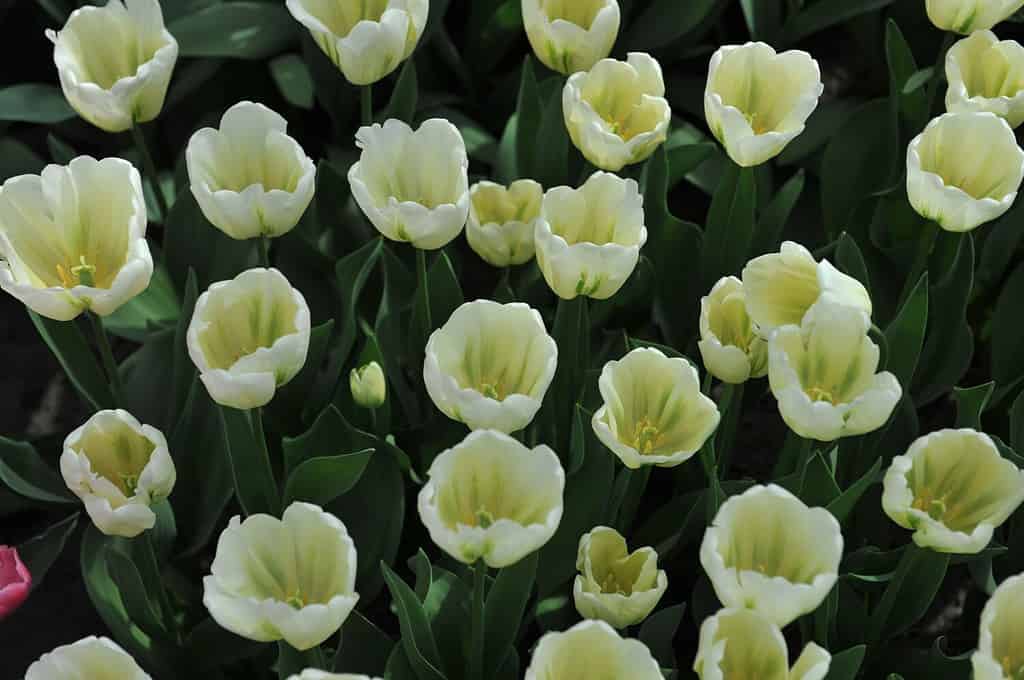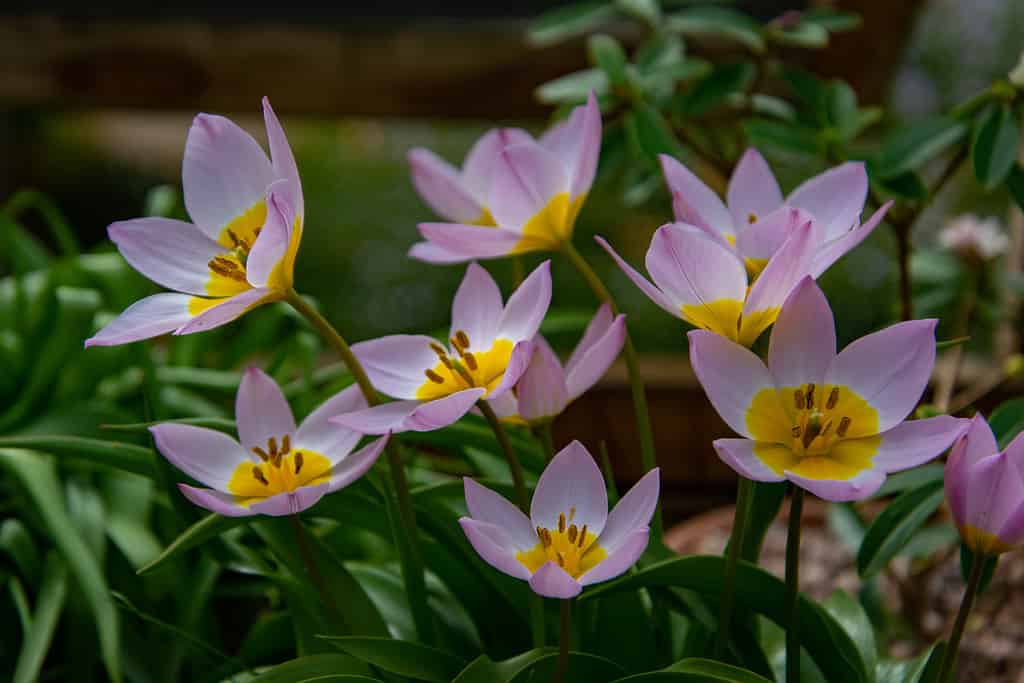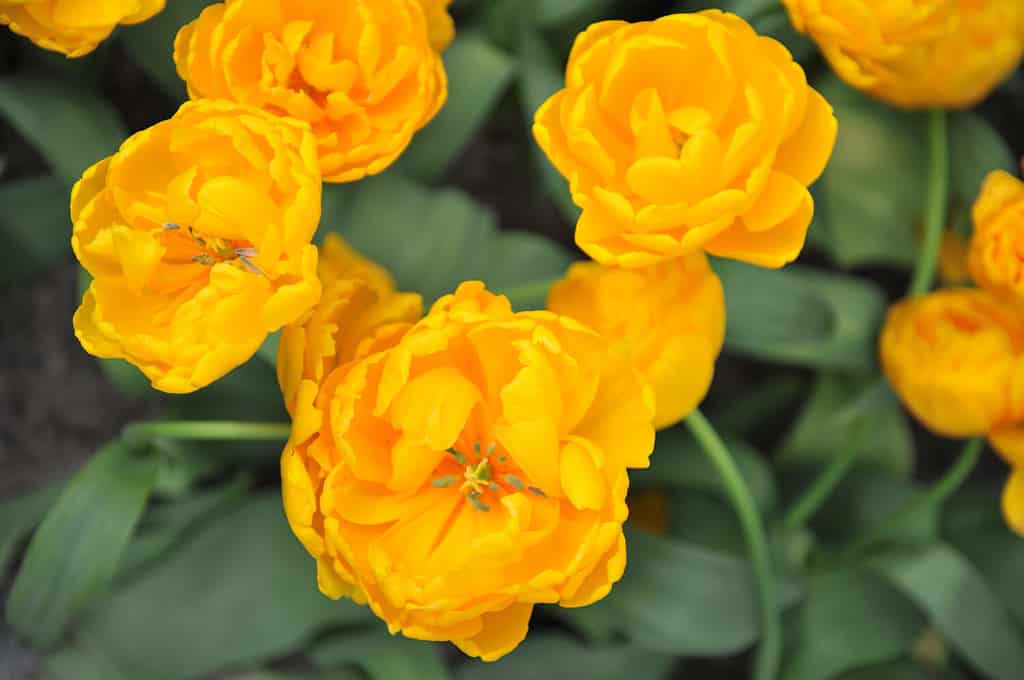Tennessee tulip lovers don’t have to travel far to find fantastic blooms come springtime. Go to the nearest flower field for a you-pick experience and get some inspiration for planting your own! When you’re ready to grow tulips in Tennessee we’ve got all the information for which types to choose, how to plant and grow them, and when to expect blooms.
Types of Tulips
Once you’ve chosen to grow tulips in your Tennessee garden, the decisions don’t stop there! Tulips come in an incredibly diverse array of colors and forms. Species Group varieties have remained close to the wildflower form of the original tulips that grew along the mountainsides of central Asia. They are often humble in stature but hardy, vibrant, and perennial. The vast majority of tulips have been hybridized and now boast double-petaled peony-esque forms, flamboyant parrot varieties, dainty lily-flowered types, and everything in between, in a rainbow of hues.
Tennessee Planting Zones
Gardeners in Tennessee should know their USDA planting zone to determine the best planting and care for their tulips. Check out the USDA planting zone map for Tennessee to find out what zone your region falls within. These are based on the average annual extreme minimum temperatures.
Tennessee planting regions fall between zones 5b and 8a. The vast majority of the state falls under zones 6a to 7b. While most tulips can perform well in warmer climates, most are rated for planting zones 3-7. Their ideal growth environment has cold winters and warm, dry summers.
Choosing Tulips to Grow in Tennessee
The tulips that grow best in Tennessee are any varieties that bloom in early-mid spring and Species Group varieties. These may fare best in Tennessee’s climate, with the potential for late spring temperature extremes in some regions. Feel free to experiment with late-spring blooming tulips, but consider planting in areas of partial shade for the longest blooms.
Tulips can thrive in all regions of the state. Here are some to try to grow in your Tennessee garden this year:
1. Tulipa ‘Beauty Queen’

For a pretty display that’s sure to pop in your Tennessee garden, chose ‘Beauty Queen’ tulips.
©Sergey V Kalyakin/Shutterstock.com
‘Beauty Queen’ is a Single Early variety with salmon-hued petals with a delicate rose blush. They are picturesque when planted in large groups, and as an added bonus, they are delightfully fragrant. They grow 12-18 inches tall on a sturdy stem. These beauties are well-built and likely to withstand rain and wind.
2. Tulipa ‘Green Spirit’

‘Green Spirit’ offers incredible, long-lasting blooms.
©Sergey V Kalyakin/Shutterstock.com
A lovely example of the Viridiflora group, Tulipa ‘Green Spirit’ features creamy white petals streaked with lime green. This unique color arrangement gives the sense that the stems and foliage of the plant are blending into the petals. Viridi is Latin for fresh and green, a fitting name for these green-tinged spring flowers. ‘Green Spirit’ is a variety that blooms late in the season, most often in May. They are excellent for cutting as their blooms are long-lasting in a bouquet.
3. Tulipa ‘Beauty of Apeldoorn’

Beauty of Apeldoorn is a classically-shaped tulip with golden petals that shine in the Tennessee sun.
©iStock.com/NVS
Beauty of Apeldoorn is a stunning Darwin Hybrid tulip variety in the classic egg shape. These radiant blooms each develop golden hues that range from mostly yellow and dusted with orange to brilliant red with golden-orange edges. A planting of Appeldoorns is a spring bouquet in itself! Darwin Hybrids are known to be sturdy, with tough stems that can withstand some wind and rain. They grow 20-24 inches tall and bloom mid-season.
4. Tulipa hageri ‘Little Beauty’

Tulipa hageri ‘Little Beauty’ is a dainty but vibrant example of a Species tulip.
©LianeM/Shutterstock.com
A member of the group known as Species, or Botanical Tulips, Little Beauty is a showy but diminutive tulip that naturalizes well. Each bulb produces 2-5 fuchsia pink, pointed petals with blue centers that are edged in white. The flower clusters are surrounded by long, narrow foliage. They share a delightful fragrance when opened with the sun but will close up at night and sometimes remain closed on cloudy days. ‘Little Beauty’ is a dwarf variety that grows to be only 4-6 inches tall. This mid-spring bloomer will perk up any landscape.
5. Tulipa saxatilis ‘Lilac Wonder’

The petals of Lilac Wonder feature a buttery yellow center.
©NKHPhotography/Shutterstock.com
A member of the Species or Botanical group, Lilac Wonder is a wildflower tulip variety with lovely little pink and softly-pointed petals. The petals fold out to expose a buttery yellow center. This is a long-lived and vigorously growing variety that is sure to do well year after year in your Tennessee garden. They grow to be 6 inches tall and bloom mid-spring.
6. Tulipa ‘Gold Fever’

‘Gold Fever’ tulips can add a special glow to your spring display.
©Sergey V Kalyakin/Shutterstock.com
‘Gold Fever’ is a Double Late variety that bursts forth in fragrant and golden yellow, double-petaled blooms during the late spring or early summer. They have a full-bodied appearance that is very similar to a peony flower. They grow to be about 18 inches tall and make for excellent cut flowers for a bouquet. These large blooms are beautiful but sensitive to extremes of weather and should be protected from heavy rains and winds.
Are Tulips Annuals or Perennials?
Tulips are technically perennial plants, not annuals. The Species group varieties that have remained close to their native form normally perform well as perennials and naturalize in the garden well. Choosing these varieties lends itself to a hands-off approach after the first year of planning and planting.
The hybridized forms have been cultivated for their boastful displays, which often require expensive energy outputs for the plant. Their displays can often lose potency in subsequent years when grown as perennials, so many gardeners choose to grow them as annuals. The benefit of choosing to grow tulips as annuals is that you can experience the incredibly expressive blooms of a number of varieties and then choose an entirely unique display the following year.
When to Plant Tulips in Tennessee
The varieties listed above can be a helpful place to start when planning for planting. Stop in to see what your local plant nursery has in stock and browse bulb catalogs for inspiration. You will want to plant your tulip bulbs when the soil has dropped to 40-50 degrees Fahrenheit and 6-8 weeks before the first predicted freeze in your area. For 5b planting zones, this will likely occur in September. For the majority of Tennessee, in zones 6-7, tulip planting will occur around late October. Zone 8 plantings will be later in November or December. For ideal growth, tulips need to experience about 12 weeks of temperatures below 50 degrees Fahrenheit.
How to Plant and Care for Tulips in Tennessee

Tulips perform best in rich, well-draining soil and prefer areas with full sun or partial shade.
©iStock.com/Jurgute
Choose a planting location that has rich, well-draining soil and amend it with soil additives if necessary. Tulips love to have lots of access to the Tennessee sun to grow properly, so choose a full-sun area if you can.
Plant your tulip bulbs about 2-3 times as deep as each bulb is tall. Cluster plantings work better for these flowers than strict rows. You’ll want to space them 3-8 inches apart, depending on the size of the bulbs and the spacing you’d like to achieve. Check that you place the bulbs in the soil with the pointed end up when planting.
After covering the bulbs with soil, a mulch layer of chopped leaves, wood chips, or shredded bark will protect the bulbs from temperature extremes and help to retain soil moisture. Give the bulbs a good, thorough watering, and then leave them to do their thing. These spring gems are mostly hands-off from this point forward. You can water them again if there is a long drought in your area, but otherwise, they will develop underground and get doused with the spring rains when they come.
Potential Plant Problems
Squirrels, voles, mice, and deer may be attracted to tulips and sometimes dig up the bulbs or nibble on the plants. You may need to devise clever fencing or other methods of keeping them out of your tulip planting area. Aphids, slugs, and snails may be present in your blooming tulip beds; they aren’t something to worry about unless they get out of hand. Tulip fire and tulip gray bulb rot are potential diseases, and improper storage of bulbs can lead to blue mold. Poorly drained soils can contribute to root or bulb rot.
When do Tulips Bloom?
Tulips bloom sometime in the spring, and when exactly bloom time will occur depends mainly on the type of tulip bulb that you choose to plant. With some careful planning, you can choose varieties of early, mid, and late-season bloomers and have tulip blooms that grow in your Tennessee garden all season long.
Where to View Tulip Gardens in Tennessee

©Lizzy Komen/Shutterstock.com
If you just can’t plant enough tulips to tickle your fancy or simply want to take in some splendid spring sights, be sure to check out some of the tulip fields of Tennessee:
Lucky Ladd Farms Tulip Festival
For the largest tulip display experience in Tennessee, head over to Lucky Ladd Farms in the greater Nashville area, near Franklin and Murfreesboro. Tulip bloom dates are from mid-March to early April. Exact dates are subject to change, so be sure to check their weekly updates posted to social media (#tuliptracker). They plant 33 varieties and over 300,000 bulbs, so guests at the you-pick farm will have an incredible abundance to choose from as they collect their bouquets at $1.50 per stem. Admission to the festival varies from $12-25 per person, and they have a $10 dog admission fee for pups in the park days.
Lorenzen Farm You-Pick Tulips
Lorenzen Farm is a you-pick tulip and sunflower farm located in Dayton, TN. March and April are tulip season on the farm. Stroll through the fragrant fields for a fantastic photo op, and take your time to pick a dazzling bouquet. Staff are on-site and available to help you choose the perfect flowers for your tastes. Admission is $5 per person, and children under 5 get in free. Tulips are $1.50 per stem and will be wrapped free of charge.
Tuliptime at Crescent Bend
Tulips bloom at the historic Crescent Bend House & Gardens by the thousands every spring. Their 3-acre formal Italian-styled gardens feature nine garden terraces and five fountains overlooking the Tennessee River. The gardens are in bloom each spring season, with over 25,000 tulips to be enjoyed by the public. Admission is $7.00 for adults, $5.00 for students, and children 12 and under are free.
The photo featured at the top of this post is © iStock.com/NVS
Thank you for reading! Have some feedback for us? Contact the AZ Animals editorial team.







